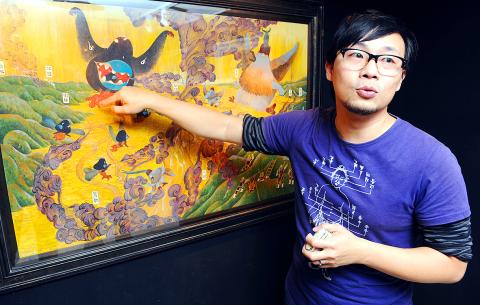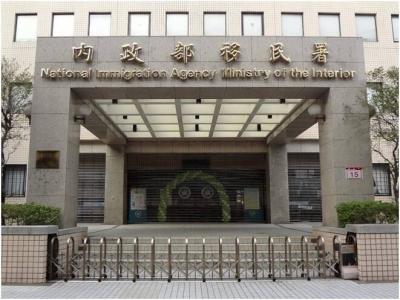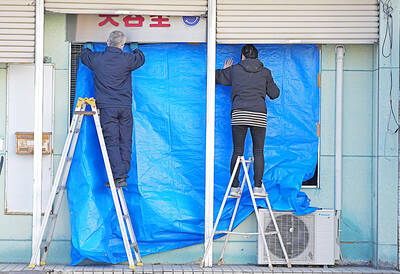An illustrated book that was two years in the making is seeking to give Taiwanese a different angle from which to view their nation by introducing readers to one of the island’s less well-known cultural elements: its rich tradition of folklore.
Taiwan Monsters (台灣妖怪地誌), created by a 37-year-old illustrator who goes by his nickname, Chiaos (角斯), and his group, focuses on the country’s rich, supernatural lore and features characters from Aboriginal legends alongside monsters invented by the book’s creators to explain natural phenomena.
Chiaos said he initiated the project partly out of his own artistic interest, but also in the hopes that the book’s subject matter will serve as a different lens through which to perceive Taiwan.

Photo: Chang Chia-ming, Taipei Times
The illustrator, who is also a designer, said he came upon the idea for the book through a news report about an old man who died in a hotspring because the temperature of the water had gradually increased, instead of staying steady.
“I was puzzled when I heard the news, because if the hotspring became hotter gradually, the man should have had time to realize it and get out of the water, unless there were outside forces preventing him from doing so,” Chiaos said.
That thought led him to reminisce about all the supernatural stories from his childhood, such as the one explaining the parrot-shaped Yingge Rock in Taoyuan County’s Yingge Township (鶯歌), or Chiayi’s “Sun Shooting” legend chronicling the origins of the moon.
Legend has it that when Koxinga (國姓爺) passed through Yingge after defeating the Dutch, he encountered a miasma exhaled by a giant parrot and ordered his troops to shoot at the bird. According to the lore, the rock was formed by the bird’s body when it fell after its neck was broken by a cannonball.
The Sun Shooting legend tells the story of two suns that took turns cycling the heavens, subjecting the Aboriginal people living under them to perpetual daytime. In a bid to end their suffering, the Aborigines chose three warriors to carry three children on a quest to shoot one of the suns down, planting trees along the way to provide food for the returning generation.
The three children grew into adults during the journey and buried the old men who had carried them before slaying one of the suns, which then became the moon.
Chiaos said the trip down memory lane inspired him to start gathering information on supernatural folklore so he could bring the legends to life through his drawings, choosing to focus on monsters and creatures rather than spirits and ghosts, because he felt they are more closely tied to the local culture and geography that they originated from.
To make the illustrations look aged, Chiaos drew the pictures on wooden boards with acrylic and powder. He also illustrated ancient maps of Taiwan so readers can gain an idea of the terrain and geography of the time when the legends were born.
Chiaos included a lot of monsters in the book, such as the Aliakakay giants from Amis’ lore, who were said to have thickly matted hair and cat-like eyes, and abducted children to eat their innards.
He made the legend of the giants his own through the creation of the Meilun Mountain (美崙), which he drew with childish features due to its diet of children’s insides.
A proponent of the anti-nuclear movement, Chiaos also created a mutant creature off the shores of Kenting (墾丁) that he said was his vision of what a shark would mutate into after being exposed to the nuclear waste from the Ma-anshan (馬鞍山) Nuclear Power Plant in Pingtung County’s Henchung Township (恆春).
Chiaos said the book has given him the chance to be like a movie director in that he had full autonomy over its setting, cast of characters and atmosphere, adding that the project also allowed him to portray his ideals.
A Taiwan Monsters exhibition will be held in Taipei’s Garden City Bookstore until April 20 that Chiaos said he mounted with financial help from online crowdfunding campaigns and NT$150,000 out of his own pocket.
“We hope that the people who come to see the exhibit or who read the book will come away with a new perspective on Taiwan, one in which culture is more prominent,” Chiaos said.

A small number of Taiwanese this year lost their citizenship rights after traveling in China and obtaining a one-time Chinese passport to cross the border into Russia, a source said today. The people signed up through Chinese travel agencies for tours of neighboring Russia with companies claiming they could obtain Russian visas and fast-track border clearance, the source said on condition of anonymity. The travelers were actually issued one-time-use Chinese passports, they said. Taiwanese are prohibited from holding a Chinese passport or household registration. If found to have a Chinese ID, they may lose their resident status under Article 9-1

Taiwanese were praised for their composure after a video filmed by Taiwanese tourists capturing the moment a magnitude 7.5 earthquake struck Japan’s Aomori Prefecture went viral on social media. The video shows a hotel room shaking violently amid Monday’s quake, with objects falling to the ground. Two Taiwanese began filming with their mobile phones, while two others held the sides of a TV to prevent it from falling. When the shaking stopped, the pair calmly took down the TV and laid it flat on a tatami mat, the video shows. The video also captured the group talking about the safety of their companions bathing

PROBLEMATIC APP: Citing more than 1,000 fraud cases, the government is taking the app down for a year, but opposition voices are calling it censorship Chinese Nationalist Party (KMT) Chairwoman Cheng Li-wun (鄭麗文) yesterday decried a government plan to suspend access to Chinese social media platform Xiaohongshu (小紅書) for one year as censorship, while the Presidential Office backed the plan. The Ministry of the Interior on Thursday cited security risks and accusations that the Instagram-like app, known as Rednote in English, had figured in more than 1,700 fraud cases since last year. The company, which has about 3 million users in Taiwan, has not yet responded to requests for comment. “Many people online are already asking ‘How to climb over the firewall to access Xiaohongshu,’” Cheng posted on

A classified Pentagon-produced, multiyear assessment — the Overmatch brief — highlighted unreported Chinese capabilities to destroy US military assets and identified US supply chain choke points, painting a disturbing picture of waning US military might, a New York Times editorial published on Monday said. US Secretary of Defense Pete Hegseth’s comments in November last year that “we lose every time” in Pentagon-conducted war games pitting the US against China further highlighted the uncertainty about the US’ capability to intervene in the event of a Chinese invasion of Taiwan. “It shows the Pentagon’s overreliance on expensive, vulnerable weapons as adversaries field cheap, technologically